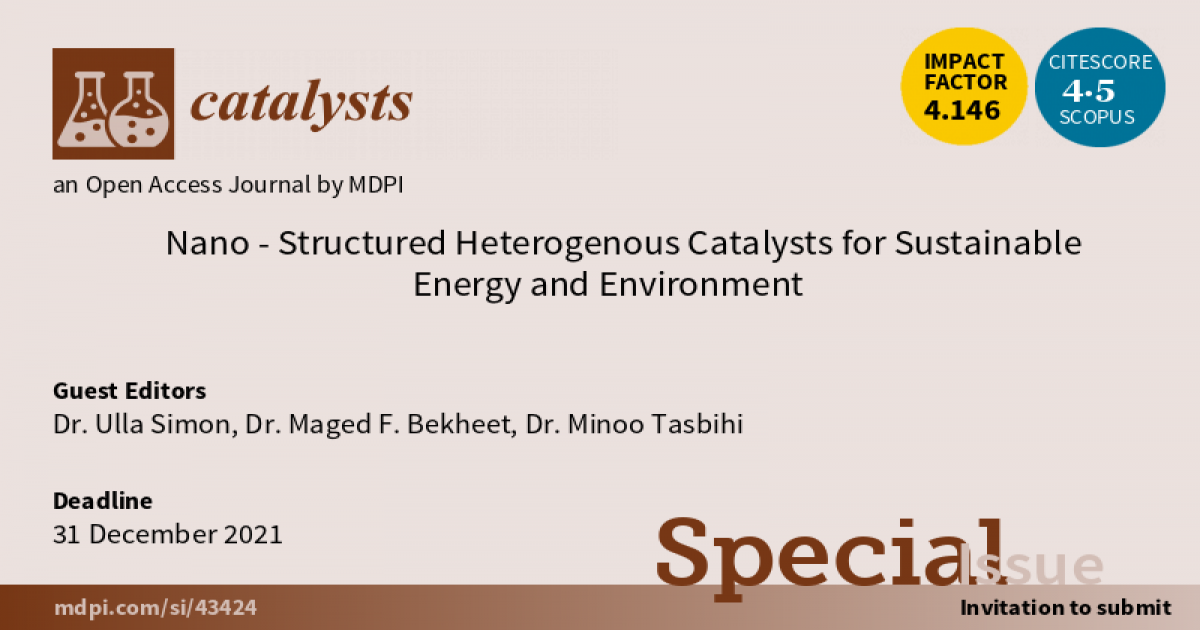- 4.0Impact Factor
- 7.6CiteScore
- 17 daysTime to First Decision
Nano-Structured Heterogenous Catalysts for Sustainable Energy and Environment
This special issue belongs to the section “Nanostructured Catalysts“.
Special Issue Information
Dear Colleagues,
Heterogeneous catalysis refers to processes where the catalyst has a different phase from the reactants and products. These catalysts usually exist in a solid phase with high capability to adsorb the reactant molecules (e.g., gas or liquids) onto their surfaces, which make them applicable for a wide range of chemical applications due to their facile separation from reactant mixtures. The catalytic efficiencies of catalysts can be greatly enhanced by reducing their particle size, often down to nanoscale dimensions, so as to significantly increase their surface area and reduce their cost. Due to environmental issues, the development of more efficient catalysts especially for sustainable industrial processes is attracting increasing attention. Further research into nano-structured catalysts with defined active sites and high stability is needed to develop tailored and stable nanomaterials, which have self-active sites or can be functionalized with active single atoms, clusters or nanoparticles.
We encourage researchers to contribute to the Special Issue on “Nano-Structured Catalysts for Sustainable Energy and the Environment”. The focus of this Special Issue is covering current research and future research trends in inorganic materials with controlled porosities and nano-structured catalysts. We will focus on i) nano-catalysts and ii) porous support materials with controlled micro-, meso- or hierarchical porosities for various catalytic reactions with particular emphasis on i) the conversion of greenhouse relevant gases (e.g., CO2 and CH4), ii) wastewater treatments from organics pollutants, and iii) water splitting applications, with a special interest in novel and innovative synthesis routes, e.g., for bifunctional catalysts and studies of metal–support interactions. In addition, the issue shall focus on in situ characterization techniques and the study of catalyst deactivation mechanisms.
Dr. Ulla Simon
Dr. Maged F. Bekheet
Dr. Minoo Tasbihi
Guest Editors
Manuscript Submission Information
Manuscripts should be submitted online at www.mdpi.com by registering and logging in to this website. Once you are registered, click here to go to the submission form. Manuscripts can be submitted until the deadline. All submissions that pass pre-check are peer-reviewed. Accepted papers will be published continuously in the journal (as soon as accepted) and will be listed together on the special issue website. Research articles, review articles as well as short communications are invited. For planned papers, a title and short abstract (about 250 words) can be sent to the Editorial Office for assessment.
Submitted manuscripts should not have been published previously, nor be under consideration for publication elsewhere (except conference proceedings papers). All manuscripts are thoroughly refereed through a single-blind peer-review process. A guide for authors and other relevant information for submission of manuscripts is available on the Instructions for Authors page. Catalysts is an international peer-reviewed open access monthly journal published by MDPI.
Please visit the Instructions for Authors page before submitting a manuscript. The Article Processing Charge (APC) for publication in this open access journal is 2200 CHF (Swiss Francs). Submitted papers should be well formatted and use good English. Authors may use MDPI's English editing service prior to publication or during author revisions.
Keywords
- Nanomaterials
- Porous materials
- Catalyst supports
- Polymer-derived ceramics
- In situ characterization
- Metal support interaction
- Heterogenous catalysis
- Water splitting
- Wastewater treatments
- Greenhouse gases

Benefits of Publishing in a Special Issue
- Ease of navigation: Grouping papers by topic helps scholars navigate broad scope journals more efficiently.
- Greater discoverability: Special Issues support the reach and impact of scientific research. Articles in Special Issues are more discoverable and cited more frequently.
- Expansion of research network: Special Issues facilitate connections among authors, fostering scientific collaborations.
- External promotion: Articles in Special Issues are often promoted through the journal's social media, increasing their visibility.
- e-Book format: Special Issues with more than 10 articles can be published as dedicated e-books, ensuring wide and rapid dissemination.

